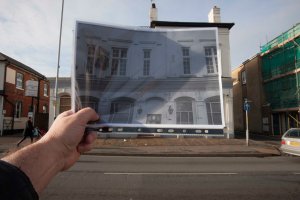As part of the TAOP course, the introduction is designed to get you to get to know your camera and has some exercises to enable you to do this. The first concerns focal length and I am going to go a bit further with it. My original idea was to take a series of shots in a nearby park but was not happy with the result (see photos below.) I thought it would be a good idea to take the three photos as indicated in the exercise, and then take photos of the resultant prints in the context of the shot taken all with a lens at standard setting.
If I my thoughts are correct it will be an interesting exercise to see how far away, or near the shots need to be from the camera addition to the distances determined in the exercise. The subject I have chosen is in Southborough high street, picking a view that is not likely to change over the day or so the exercise is carried on over.
I also had a look at my existing shots on Flickr using a neat tool that searches the exif data of your Flickr collection. It can be found here:- http://stats.ghusse.com. My full frame lenses range from 12mm to 400mm (12-24;24-70;70-400) and so I concentrated on this range as I wanted to see how many shots I had taken at or around the “standard” 50mm focal length. As can be seen from the chart below, of some 3200 pictures only 68 were around that length with no real common type of useage.
So by this, very rough, analysis this standard length, in my useage to date, has not been used to extent that might have been expected. It begs the question then, that if you are not constrained by having a 50mm or equivalent prime lens, would you normally take shots in the same manner as you would see them? On this evidence, which I find reassuring – in that there is a wide variety of focal lengths used, the answer is that I usually do not.
These are the rejected shots taken at Knole Park:-
24mm
50mm
70mm
All three shots taken on 1 December 2013 with Sony A900 and Zeiss 24-70 at F4 at speeds of 1/60, 1/30 & 1/20 respectively. ISO 160
I went instead for these three shots of the now closed Flying Dutchman Pub in Southborough high street as I felt they were more interesting than the Knole Park shots, and also considered that it may useful to revisit the pub once its is reopened/redeveloped:-
24mm
50mm
70mm
All three shots taken on 2 December 2013 with Sony A900 and Zeiss 24-70 at F22 at speeds of 1/5, 1/4 & 1/4 respectively. ISO 400
The next step is to print these off and and carry out the exercise and also retake the above 24 mm shot with the prints included in the shots.
6th December 2013
Having printed off the three shots of the pub above at A4 I revisted the point from where I took them. In aligning the shots I found the 24mm shot needed to be held about 3-4 inches from my eyes to align with the actual subject. As had been indicated in the exercise instructions, at 50mm (the “standard” length) it was a comfortable bent arms length away for alignment, about 20 -22 incles while the 70mm needed a real stretch to get it aligned at about 35-37 inches,see pictures below, both taken at 24mm and f22:-
50mm
With hindsight I should have mounted the photos on card so as to easier align them but I think these shots indicate the difference as to the distance to alignment. However I must ask if 50mm is the standard focal length and is the “comfortable” viewing distance why aren’t more shots, both my own and in general, shot at that length? The answer is, in my view, that photographers will not necessaily see the conventional view. They have a tendency to either hone in on a particular aspect of a scene they are considering, or widen the view, perhaps to show the subject in context – or how big or little it is in comparison with other aspects of the shot.








